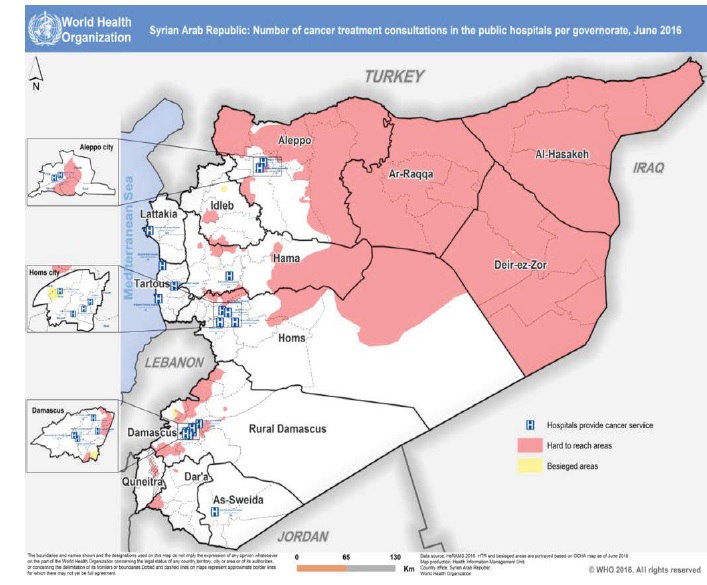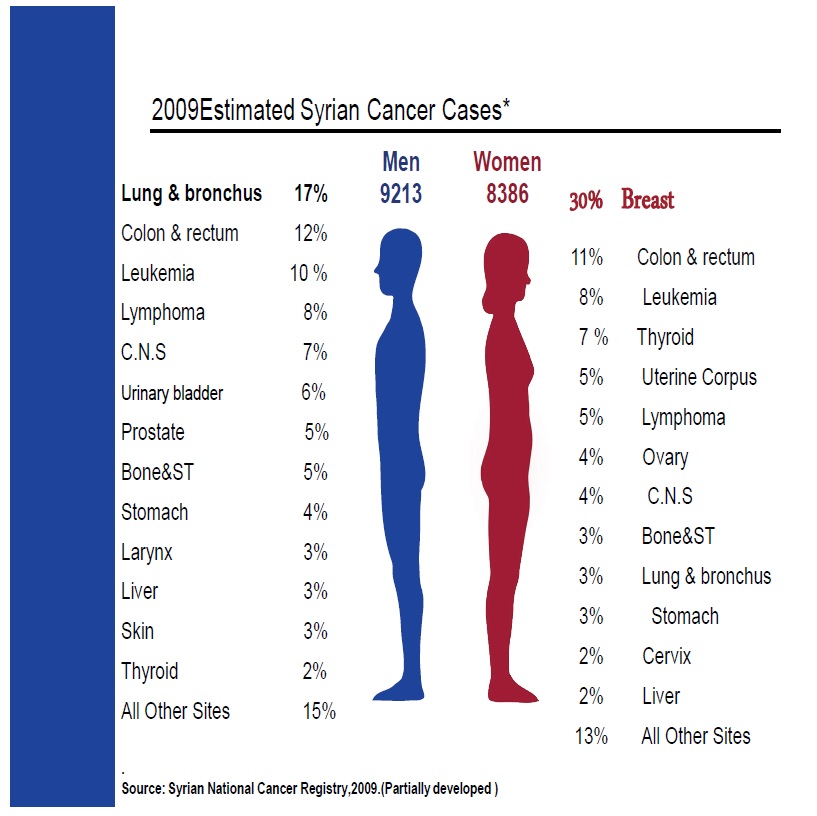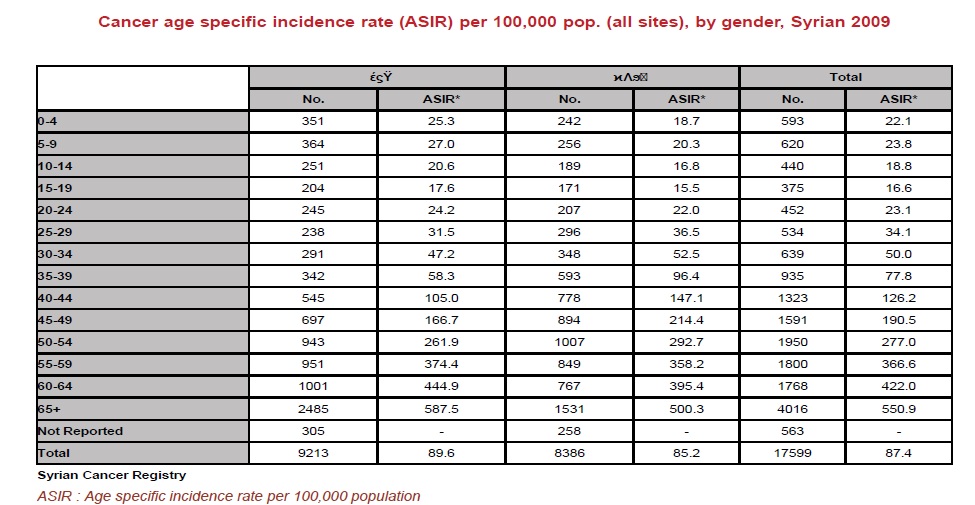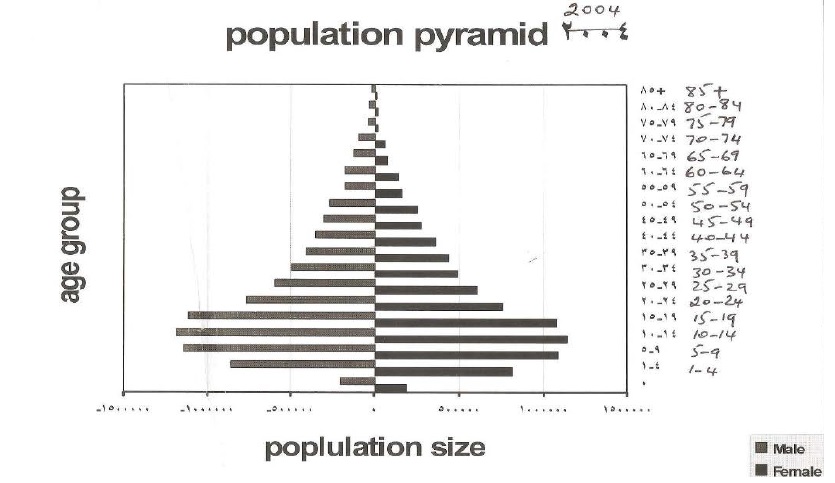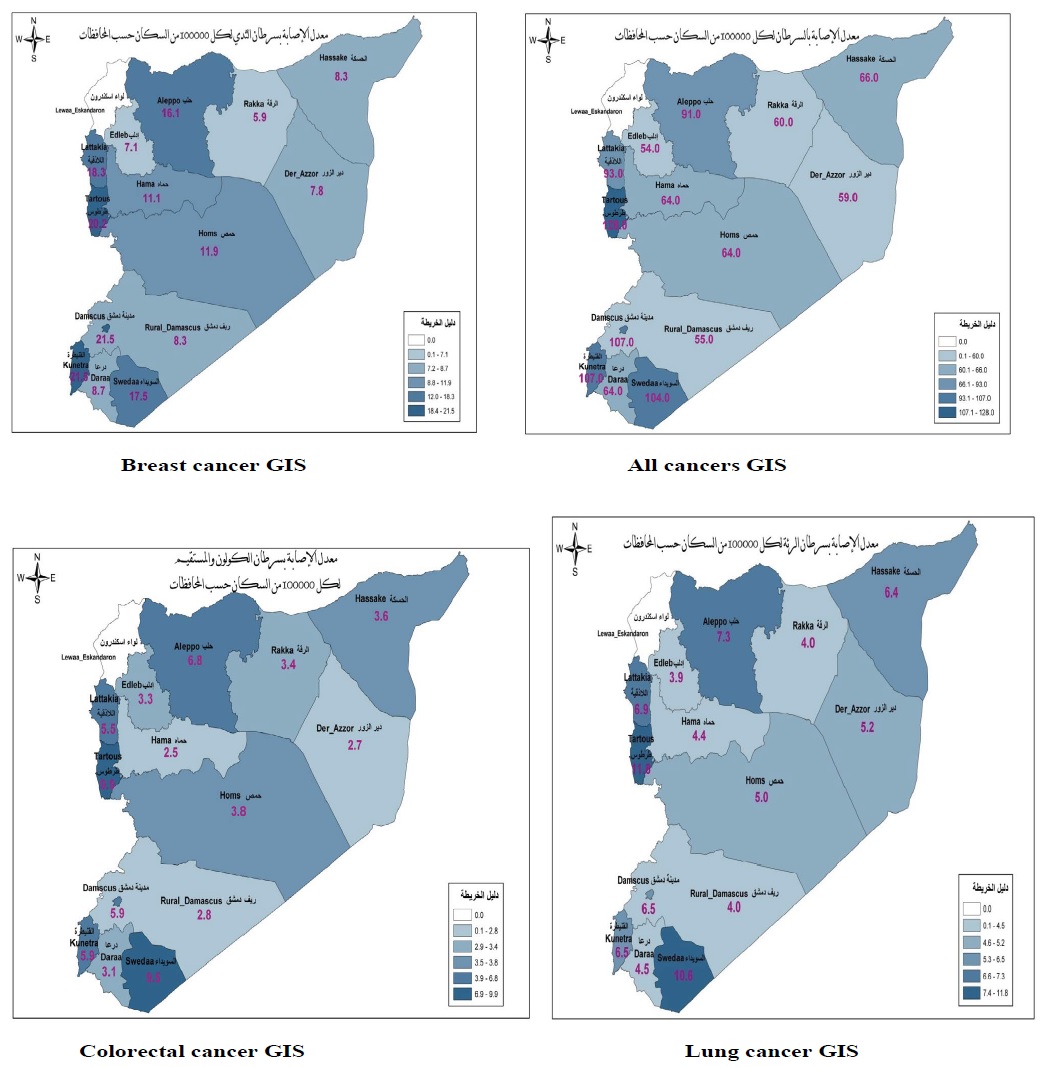Journal Name: International Journal of Cancer and Treatment
Article Type: Research
Received date: 20 March, 2018
Accepted date: 15 April, 2018
Published date: 30 May, 2018
Citation: Simaan S, Jerf FA (2018) Cancer in Syria (magnitude of the problem). Int J Cancer Tremnt. Vol: 1, Issu: 1 (10-15).
Copyright: © 2018 Simaan S, et al. This is an open-access article distributed under the terms of the Creative Commons Attribution License, which permits unrestricted use, distribution, and reproduction in any medium, provided the original author and source are credited.
Abstract
Purpose: To explore and know where we stand in cancer in Syria, we depended on the Syrian National Cancer Registry (SNCR) which is a hospital-based registry (partially developed) established in 2002 and located in the Ministry of Health A total number of 17599 new cases were registered by Syrian Cancer Registry during 2009., 9213 (52%) were males and 8386 (48%) were females. Due to the ongoing conflict since 2011 and inadequate data, we are unable to collect reliable information since then.
Methods: The crude and the Age Standardized Rate (ASRs) per 100,000 population were calculated and compared with contrasts in some developed and developing countries.
Results: Cancer is the third main cause of death in Syria. In men the most frequent cancer site was the lung (17%), followed by colon and rectum (12%) and Leukemia (10%). In women the most frequent cancer sites were breast (30%), colon and Rectum (11%) and Leukemia (8%). The Age Standardized Rate (ASR) for all cancer combined was 128 per 100,000 for males and 117 per 100,000 for females. The percentage of microscopically verified cases was about 70%. The most common causes of death were lung cancer in males and breast cancer in female. The estimated mortality rate for cancer was 52 and 76 per 100 000 for females and males in 2009.
Conclusion: The current low cancer incidence rates in Syria might be due to lack of national cancer screening programs especially for prostate, colorectal, breast, uterine cervix and oral cancer. There is still an attitude of fear and fatalism among the public that prevent many from consultation and treatment.
In the last decade, there has been noticeable better survival rates due to earlier detection and better treatment. All this was due to more cancer awareness and public education in addition to better treatment provided by our governmental medical institutions and hospitals that provide free medical care.
Keywords
Breast cancer, Colorectal cancer, Lung cancer, Childhood Cancer.
Abstract
Purpose: To explore and know where we stand in cancer in Syria, we depended on the Syrian National Cancer Registry (SNCR) which is a hospital-based registry (partially developed) established in 2002 and located in the Ministry of Health A total number of 17599 new cases were registered by Syrian Cancer Registry during 2009., 9213 (52%) were males and 8386 (48%) were females. Due to the ongoing conflict since 2011 and inadequate data, we are unable to collect reliable information since then.
Methods: The crude and the Age Standardized Rate (ASRs) per 100,000 population were calculated and compared with contrasts in some developed and developing countries.
Results: Cancer is the third main cause of death in Syria. In men the most frequent cancer site was the lung (17%), followed by colon and rectum (12%) and Leukemia (10%). In women the most frequent cancer sites were breast (30%), colon and Rectum (11%) and Leukemia (8%). The Age Standardized Rate (ASR) for all cancer combined was 128 per 100,000 for males and 117 per 100,000 for females. The percentage of microscopically verified cases was about 70%. The most common causes of death were lung cancer in males and breast cancer in female. The estimated mortality rate for cancer was 52 and 76 per 100 000 for females and males in 2009.
Conclusion: The current low cancer incidence rates in Syria might be due to lack of national cancer screening programs especially for prostate, colorectal, breast, uterine cervix and oral cancer. There is still an attitude of fear and fatalism among the public that prevent many from consultation and treatment.
In the last decade, there has been noticeable better survival rates due to earlier detection and better treatment. All this was due to more cancer awareness and public education in addition to better treatment provided by our governmental medical institutions and hospitals that provide free medical care.
Keywords
Breast cancer, Colorectal cancer, Lung cancer, Childhood Cancer.
Introduction
Syria as a developing nation is in epidemiological transition state from communicable to non-communicable diseases status [1]. Although, cancer is the third cause of death in Syria, its mortality is on the rise during recent decades. This review was carried out to provide a general viewpoint on common cancers incidence in Syria (Report 2009) and to explain differences that may help us to establish early detection programs and investigate population risk factors [2].
Overall age-standard incidence rate per 100, 000 population according to primary site is 128 in males and 117 in females. The five most common cancers are lung, colon-rectum, leukemia, lymphoma and CNS in males, and in females are breast, colon-rectum, leukemia, thyroid and uterine corpus.
The incidence rate of colon and rectum cancers are on the rise in Syria. Syria, which is located in west Asia, is in an epidemiologic transition and faces the double burden of diseases [3]. According to the WHO, the life expectancy of the average Syrian in 2012 was 75.7 years, (a leap from an average of 56 years in 1970). Infant mortality dropped from 132 per1000 live births in 1970 to 17.9 per1000 in 2009, Under-five, mortality dropped significantly from 164 to 21.4 per 1000 live births, Maternal mortality fell from 482 per 100 000 live births in 1970 to 52 in 2000 [4].
Syria ended the year 2009 with a population of 21,092,000 people, which represents an increase of 511,000 people compared to 2008. The male population is greater in males with 10,527,281 men, compared to 10,297,612 women. Syria, with 114 people per square km was in 125th position in general ranking of density population in 2009 [5].
The demographic and epidemiological transition that is underway will have a significant impact on the pattern of morbidity and mortality in the near and distant future, especially as it affects the emergence of chronic noncommunicable diseases, health problems of an aging population and disability. In addition, cancer is a major public health problem in Syria. Based on recent reports from the Ministry of Health; it is the third cause of death in Syria after coronary heart disease and respiratory disease. Unfortunately, few national programs according to the World Health Organization (WHO), guidelines for cancer screening and prevention are not active in Syria. There are many problems: the financial burden of different types of treatment, the advanced stage at presentation of cancer patients, as well as inadequate medical staff training for diagnosis, treatment, palliative care, and psychological care of cancer patients. Therefore, it seems that maximizing web-based systems for communication, education, and collaboration between organizations are needed [5].
Methods
Syrian National Cancer Registry (SNCR), which is a hospital-based registry (partially developed) was established in 2002 and located in the Ministry of Health hoping in the future our data will be population-based.
The Source of data that SNCR used have been from pathology Laboratories and from hospitals (partially developed) over Syria, there is about 30 % lack in data. There are several difficulties in the collection of cancer mortality, since a lot of Cancer-related deaths were not correctly reported (especially in rural areas). A total of 9213 cancer cases in males and a total of 8386 cancer cases in females were collected in the year 2009.
All cancer cases were reported to the Ministry of Health according to the International Classification of Diseases-Oncology (ICD-O). In practice, the principal sources of cancer registries are hospital records and records from some diagnostic departments, histopathology. When possible, death certificates in which cancer is included as a main or contributory cause of death are also used (Figure 1).
Figure 1: Map of Syria.
Results
The most common three cancers in males were lung, Colo-rectal and leukemia, while the most common three cancers in females are breast, colorectal and leukemia (Table 1) (Figure 2).
Table 1: 5 common cancers in Syria.

Figure 2: 2009 Estimated Syrian cancer cases.
Breast cancer
Breast cancer (BC) is the most common cancer among women and accounting for 30 % of all female cancers. The behavior and characteristics of BC in Syria was found not much different than that of the neighboring countries like Lebanon, Jordan, KSA and Egypt as far as the low median age of incidence and late presentation is concerned. The behavior of BC was found quite different than seen in the Western countries.
The crude incidence rate and ASR of 29 and 43 per 100,000. and the mortality ratio (BC) about 24%. It is problematic to predict future patterns and perform the most appropriate preventive and therapeutic measures in order to decrease the burden of this disease in our society. The few small studies and reports available in Syria suggest that breast cancer affects Syrian women at least one decade younger than women in developed countries, with the mean age 49 years.
About 41.5% of women with breast cancer presented with stage III disease, followed by 27.5% presenting with stage IV disease. While only 21% presenting in Stage II and 10% presenting in stage as shown by Simaan’s review [6]. This review also showed that as much as 25 % of breast cancer patients were below the age of 40. This might be explained by the fact that 82 % of our population is below the age of 40 as according to the population pyramid in Syria as shown above.
According to Syrian national cancer registry, stage III & stage IV account for about 73% We should mention that cancer registries are supposed to cover a broader spectrum of the population. Further studies are needed to map out the exact breast cancer incidence rate and trends over time in order to determine possible environmental, lifestyle and/or genetic risk factors in Syria (Figure 3).
Figure 3: Cancer age specific incidence rate (ASIR) per 100,00 pop. (all sites), by gender, Syrian 2009.
Colorectal cancer
The burden of this disease is expected to increase dramatically in the near future. CRC is the second most common cancer amongst males (ASR:18) and the second amongst females (ASR:12). The mortality ratio (CRC) about 11%,10% for males and females, respectively [2].
These incidence rates are close to those reported from other middle-eastern countries and lower than those seen in western countries, with the mean age of 51 year, and 23% under 35 years of age [2-7].
About 48% of CRC presented with stage III disease, followed by 28% presenting with stage IV disease. While only 16% presenting in Stage II and 8% presenting in stage I.
The rate of screening is very low globally and negligible in both Syria and many other developing countries. This is due to cost, resistance by physicians, patients, and the healthcare system. In Syria, screening should at least be started in family members of CRC patients at an earlier age with colonoscopy as the preferred screening modality (Figure 4).
Figure 4: Population pyramid.
Lung cancer
Lung cancer (LC) is the most common cancer among men and accounting for 17 % of all male cancers, and 3% of all women cancers.
The crude incidence rate and ASR of 15 and 24 per 100,000 with the mean age of 67 years. Unfortunately, lung cancer is detected in later stages and the mortality ratio (LC) is about 20%.
New research shows a significant link between lung cancer and cancer-causing chemical pollution, especially from large industrial facilities such as oil refinery [3].
Childhood Cancer
Childhood cancer accounts for 10% of all cancer cases, (1760) were children. Unfortunately, it is expected that 800 of them will not survive. In 2013, there were about 2500 -3000 children diagnosed with cancer [2-9]. The most common types of cancer among children 0- 15 years old are leukemia and brain cancers (Table 2) (Figure 5).
Table 2: The common type of cancer among children 0- 15 years old.

Figure 5: Geographic Information System GIS.
Conclusion
A functional national cancer registry to be used as source of data for epidemiologic research /studies, and programs of early detection and cancer screening is quite weak. Breast and colon cancer were diagnosed at late stages. Patients are unaware of the procedures for early detection of cancer and they are afraid of the disease and the procedure itself. Educational programs for patients and oncology health workers are not available.
Cytogenetic and flow cytometry services are not available in all the hospitals where the study was conducted. Hospitals are facing obstacles to regular availability of pathology services including the limited resources for procurement, unreliable supply chain and non-functioning equipment. Treatment costs and stigma associated with treatment were the main factors for failure to seek treatment. While factors related to accessibility to the hospital, fragmented referral mechanisms to higher levels of care, and unawareness of patient and their families were additional reasons for failure to obtain treatment. All the hospitals were not able to get consistent supply of the essential chemotherapeutic drugs. Fifty-five% of patients completed the systemic therapy/ chemotherapy without interruption and 46% completed their radiotherapy without interruption.
Recommendations
- To seek WHO support for the implementation of the development of a national strategy for cancer care to reduce cancer incidence and mortality and improve quality of life of cancer patients, through the systematic and equitable implementation of evidence-based strategies for prevention, early detection, diagnosis, treatment, palliation, training and research while making the best use of available resources.
- To undertake an assessment of the capacity of the national cancer registry in coordination with WHO regional office and IARC.
- Establish national cancer database that links MOH Health Information System to the national data set for cancer (cancer registry) population-Based
- Develop reinforcement policies for prevention of cancer diseases such as tobacco control policy and immunization against Hepatitis B.
- Making essential medicines and medical equipment for cancer care available in the country.
- To build the capacity of health workers working in oncology health care in the areas of palliative care, early detection, nutrition and diagnosis services.
- To develop a communication strategy for raising awareness of cancer in the community.
World Health Organization (2009) Towards a strategy for cancer control in the Eastern Mediterranean Region. [ Ref ]
Ziad M, Ahmad E, Al Jerf F (2009) Cancer Incidence in Syria- cancer registry- Ministry of Health publication. [ Ref ]
UNRWA (2014) Alienation And Violence: Impact Of The Syria Crisis In 2014, [https://www.unrwa.org/resources/reports/alienation-andviolence- impact-syria-crisis-2014]. [ Ref ]
IHME (2009) Central Bureau of Statistics, [http://ghdx.healthdata.org/ organizations/central-bureau-statistics-syria]. [ Ref ]
World Health Organization (2015) Regional situation analysis on the provision of NCD care during emergencies Syria country mission. [ Ref ]
Suheil Simaan (2017) Clinical and Pathological Characteristics of Breast Cancer in Syria. Int J Cancer Res & Treatment 2: 1-4. [ Ref ]
Sandouk F, Al-Jerf F, Al-Halabi B (2013) Precancerous Lesions in Colorectal Cancer. Gastroenterology Research and Practice. [ Ref ]
Masri FA and Yusuf AS (2012) High Incidence Rate of Lung Cancer in Oil Refinery Counties Journal of Medical and Bioengineering 1: 22-25. [ Ref ]
Faris G, Mouhamed M, Al Jerf F, Khder N, Alnakry E, et al. (2016) Rapid Assessment of Cancer Management Care in Syria, December- 2016. [ Ref ]
